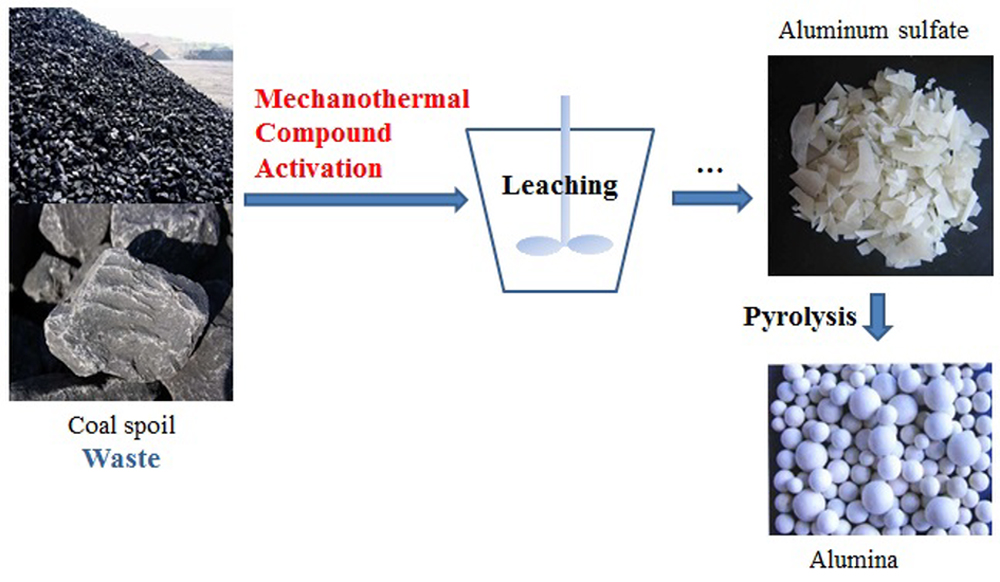

Frontiers of Chemical Science and Engineering >
Leaching of aluminum from coal spoil by mechanothermal activation
Received date: 11 Mar 2015
Accepted date: 15 May 2015
Published date: 14 Jul 2015
Copyright
The process of activating coal spoil (CS) in order to recover aluminum as a high value product was investigated. The CS was first characterized by X-ray fluorescence (XRF), X-ray diffraction (XRD) and thermogravimetric analysis-differential scanning calorimetry (TGA-DSC) in order to determine the chemical and mineral compositions of the CS. Then a mechanothermal activation method was adopted to increase the aluminum activity in the coal spoil. Over 95% of the aluminum in the CS could be extracted using this activation method. The mechanothermal activation process promoted the destruction of kaolinite structures and hindered the formation of amorphous γ-Al2O3. This resulted in a high aluminum leaching activity in the mechanothermally activated CS.

Key words: coal spoil; mechanothermal compound activation; leaching
Xiaoxue SUN , Yuzhu SUN , Jianguo YU . Leaching of aluminum from coal spoil by mechanothermal activation[J]. Frontiers of Chemical Science and Engineering, 2015 , 9(2) : 216 -223 . DOI: 10.1007/s11705-015-1518-2
| 1 |
Liu H B, Liu Z L. Recycling utilization patterns of coal mining waste in China. Resources, Conservation and Recycling, 2010, 54(12): 1331-1340
|
| 2 |
Livingston W R, Rogers D A, Chapman R J, Bailey N T. The use of coal spoils as feed materials for alumina recovery by acid-leaching routes. 1. The suitability and variability of the feed materials. Hydrometallurgy, 1983, 10(1): 79-96
|
| 3 |
Livingston W R, Rogers D A, Chapman R J, Gregory A G, Bailey N T. The use of coal spoils as feed materials for alumina recovery by acid-leaching routes. 2. The effect of the calcination conditions on the leaching properties of the colliery spoil. Hydrometallurgy, 1983, 10(1): 97-109
|
| 4 |
Livingston W R, Rogers D A, Chapman R J, Bailey N T. The use of coal spoils as feed materials for alumina recovery by acid-leaching routes. 3. The effect of the leaching conditions on the extraction of aluminium and iron from a fluidised bed ash. Hydrometallurgy, 1985, 13(3): 283-291
|
| 5 |
Mahi P, Bailey N T. The use of coal spoils as feed materials for alumina recovery by acid-leaching routes. 4. The extraction of iron from aluminiferous solutions with amines, in particular Alamine 336. Hydrometallurgy, 1985, 13(3): 293-304
|
| 6 |
Bailey N T, Chapman R J. The use of coal spoils as feed materials for alumina recovery by acid-leaching routes. 5. The effect of fluoride additions on the extraction of aluminum with hydrochloric acid. Hydrometallurgy, 1987, 18(3): 337-350
|
| 7 |
Mahi P, Livingston W R, Rogers D A, Chapman R J, Bailey N T. The use of coal spoils as feed materials for alumina recovery by acid-leaching routes. Part 6: The purification and crystallization of chloride and chloride/fluoride leach liquors by HCl gas precipition. Hydrometallurgy, 1991, 26(1): 75-91
|
| 8 |
Sun X X, Sun Y Z, Yu J G. Cooling crystallization of aluminum sulfate in pure water. Journal of Crystal Growth, 2015, 419: 94-101
|
| 9 |
Sun X X, Sun Y Z, Yu J G. Crystal structure of aluminum sulfate hexadecahydrate and its morphology. Crystal Research and Technology, 2015, 50(4): 293-298
|
| 10 |
Aglietti E F, Porto-Lopez J M, Pereira E. Mechanochemical effects in kaolinite grinding. I. Textural and physicochemical aspects. International Journal of Mineral Processing, 1986, 16(1-2): 125-133
|
| 11 |
Aglietti E F, Porto-Lopez J M, Pereira E. Mechanochemical effects in kaolinite grinding. II. Structural aspects. International Journal of Mineral Processing, 1986, 16(1-2): 135-146
|
| 12 |
Qiao X C, Si P, Yu J G. A Systematic investigation into the extraction of aluminum from coal spoil through kaolinite. Environmental Science & Technology, 2008, 42(22): 8541-8546
|
| 13 |
Cheng F, Cui L, Miller J D, Wang X. Aluminum leaching from calcined coal waste using hydrochloric acid solution. Mineral Processing and Extractive Metallurgy Review, 2012, 33(6): 391-403
|
| 14 |
Guo Y X, Li Y Y, Cheng F Q, Wang M, Wang X M. Role of additives in improved thermal activation of coal fly ash for alumina extraction. Fuel Processing Technology, 2013, 110: 114-121
|
| 15 |
Li C, Wan J H, Sun H H, Li L T. Investigation on the activation of coal gangue by a new compound method. Journal of Hazardous Materials, 2010, 179(1-3): 515-520
|
| 16 |
Shen X. Differential Thermal and Thermogravimetric Analysis and Non-isothermal Kinetics of Solid. China: Metallurgical Industry Press, 1995, 22-96 (in Chinese)
|
| 17 |
Mullin J W. Crystallization. 3rd ed. UK: Butterworth-Heinemann, 2000, 78-80
|
| 18 |
Qiu X H, Zhang Q J. Mechanochemical changes of kaolinite during dry grinding. Journal of the Chinese Ceramic Society, 1991, 19(5): 448-455
|
| 19 |
Young R A, Hewat A W. Verification of the triclinic crystal structure of kaolinite. Clays and Clay Minerals, 1988, 36(3): 225-232
|
| 20 |
Wong S F. Fourier Translation Infrared Spectroscopy. Beijing: Chemical Industry Press, 2010, 328-331 (in Chinese)
|
| 21 |
Percival H J, Duncan J F, Foster P K. Interpretation of the kaolinite-mullite reaction sequence from infrared absorption spectra. Journal of the American Ceramic Society, 1974, 57(2): 57-61
|
| 22 |
Frost R L, Vassallo A M. The dihydroxylation of the kaolinite clay minerals using infrared emission spectroscopy. Clays and Clay Minerals, 1996, 44(5): 635-651
|
| 23 |
Mukherjee S, Srivastava S K. Minerals transformations in northeastern region coals of India on heat treatment. Energy & Fuels, 2006, 20(3): 1089-1096
|
| 24 |
Si P. Activation technology for aluminum recovery from coal spoil through acid leaching route. Dissertation for the Doctoral Degree. Shanghai: East China University of Science and Technology, 2011, 68-70
|
/
| 〈 |
|
〉 |